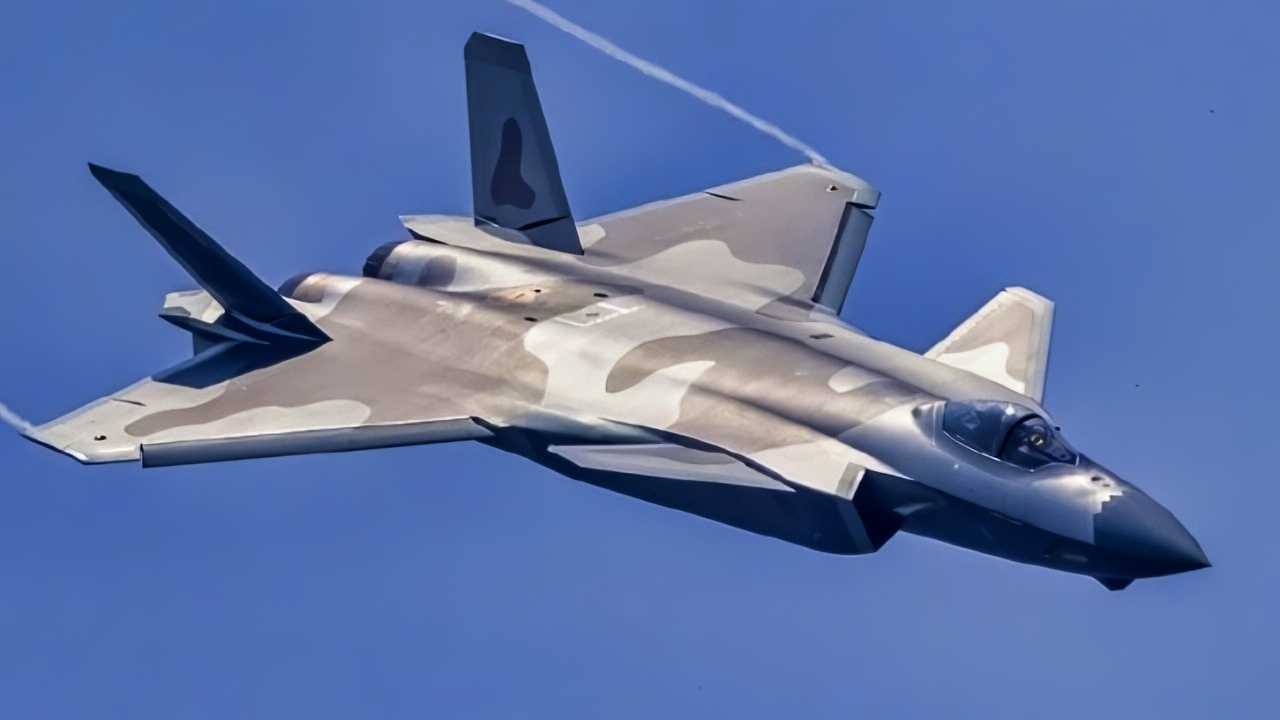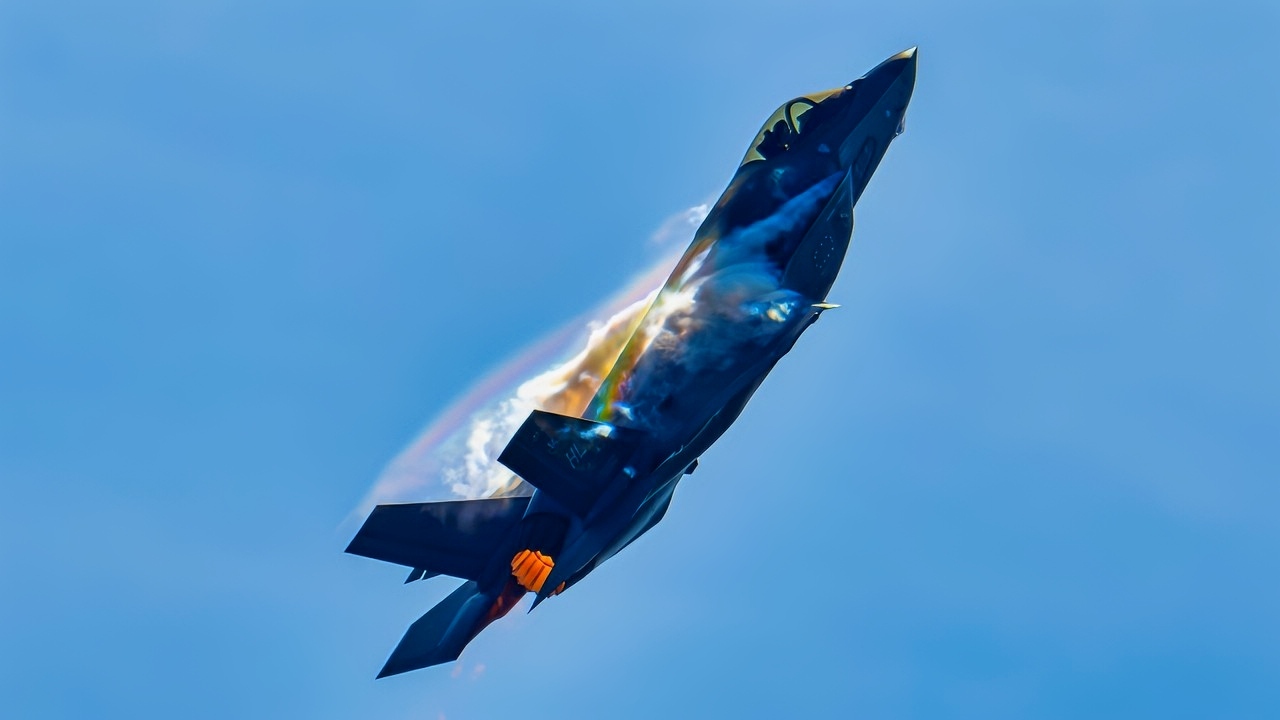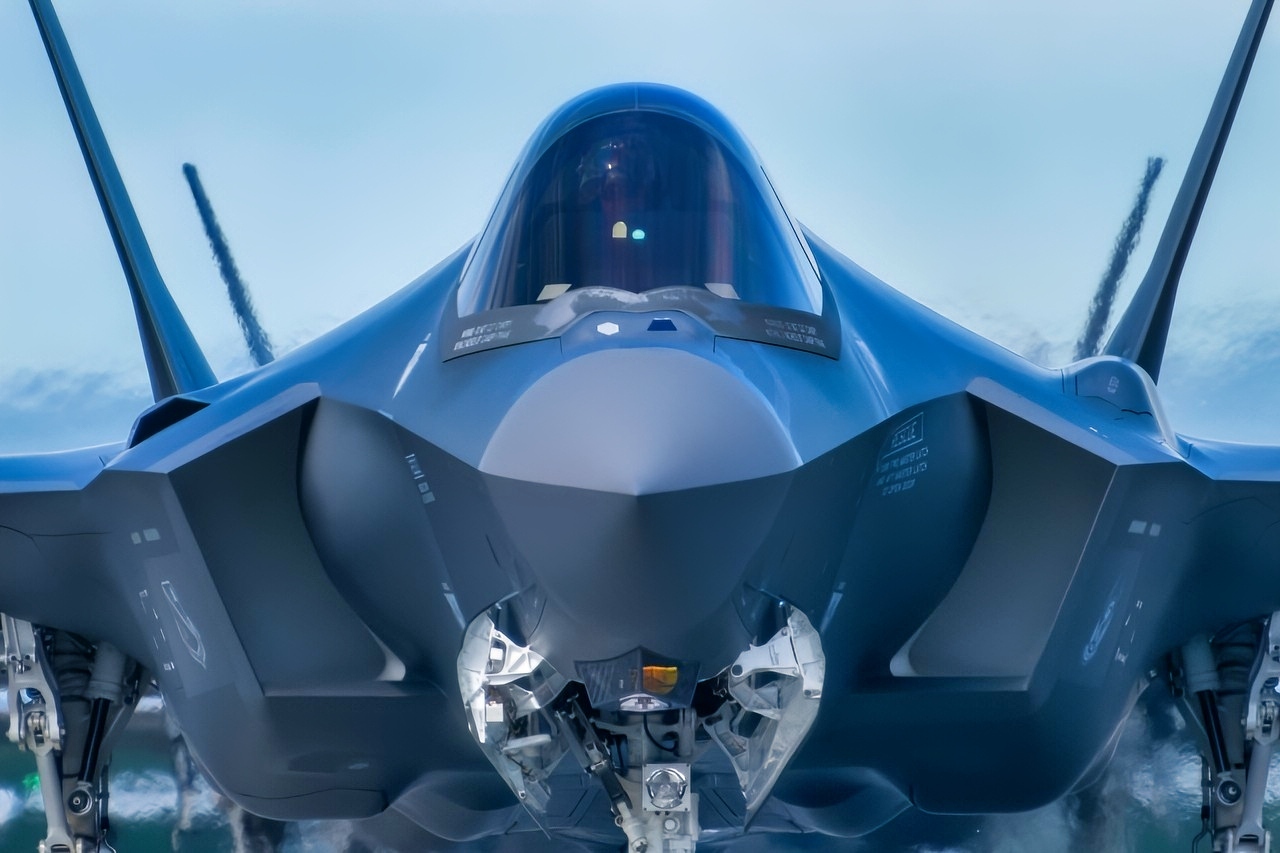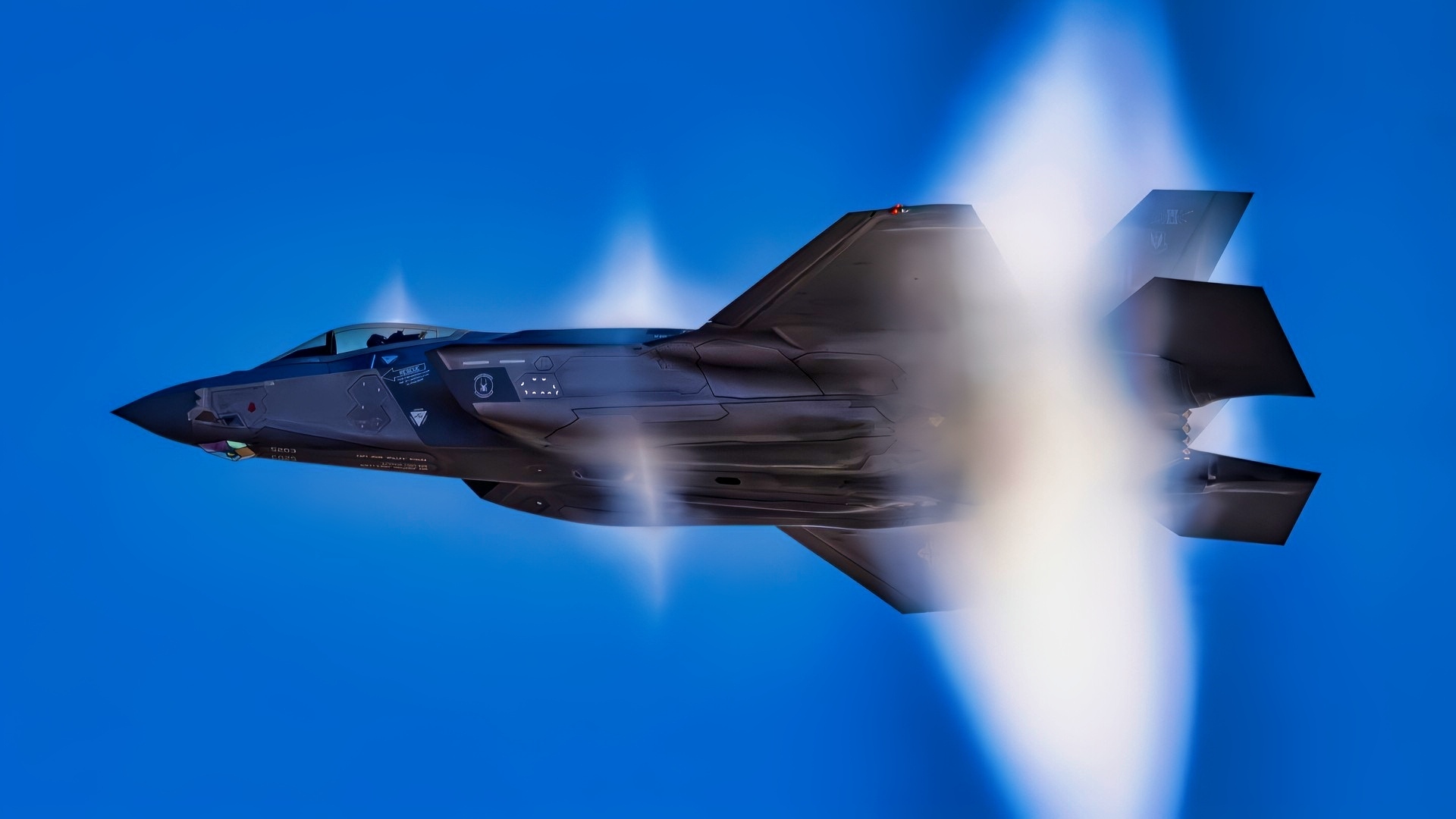Key Points and Summary – America’s F-35 is a multirole stealth “sensor node” built around deep sensor fusion, low observability, and seamless data-sharing across a carrier or joint force. China’s twin-engine J-20A emphasizes range, speed, and long-reach missiles like PL-15, with frontal stealth and big internal bays for high-value intercepts.
-In BVR, the F-35’s smaller signature and fused picture likely yield first detection and first shot; the J-20 threatens if it can see and shoot from afar.

China J-20A Fighter in the Sky. Image Credit: Creative Commons.
-In WVR, neither jet is a pure dogfighter, but the F-35’s helmet cueing and compact agility help.
-Overall edge: F-35’s stealth and avionics—especially with networked support.
J-20A vs. F-35: Who Wins?
Ever since its acceptance into service in 2015, the F-35 has been a vital cornerstone of American air dominance.
With over 1,200 units built, it is the most widely produced and used stealth fighter on the planet and has gained international success on the global market.
If a war with China were ever to break out, the F-35 would be one of the first fighters in the air. On the other hand, the Chengdu J-20A just might be China’s premier stealth fighter.
Both fighters are highly advanced and would likely face off against each other in the event of a broader conflict, but which fighter would prevail over the other?
The J-20A vs the American Beast
The F-35 was developed as a multirole stealth fighter intended to serve across the U.S. Air Force, Navy, and Marine Corps, as well as allied nations.
It comes in three variants: the conventional takeoff and landing F-35A, the short takeoff and vertical landing F-35B, and the carrier-capable F-35C. Its design emphasizes versatility, survivability, and integration into a networked battlespace.
The aircraft is equipped with advanced sensor fusion, electronic warfare capabilities, and a low radar cross-section that allows it to operate undetected in contested environments. The F-35 is not just a fighter; it is a flying sensor node capable of collecting, analyzing, and distributing battlefield data in real time.

U.S. Air Force Maj. Melanie “Mach” Kluesner, F-35A Demonstration Team pilot, performs aerial maneuvers during the Abbotsford International Airshow in British Columbia, Canada, Aug. 9, 2025. The team travels worldwide to demonstrate the capabilities and precision of the U.S.’s most advanced fifth-generation fighter. (U.S. Air Force photo by Senior Airman Nicholas Rupiper)

U.S. Air Force aircraft participate in a capabilities demonstration in honor of the U.S. Air Force’s 75th Anniversary at Eielson Air Force Base, Alaska, Aug. 12, 2022. Aircraft, including F-35A Lightning II, F-16 Fighting Falcon and F-22 Raptor aircraft, participated in the 75-fighter jet formation. (U.S. Air Force photo by Tech. Sgt. Timothy Moore)
In contrast, the J-20A was developed by China’s Chengdu Aerospace Corporation as a long-range air superiority fighter with stealth capabilities. It is larger than the F-35 and designed primarily for intercepting high-value targets and asserting dominance in the air.
The J-20A features a twin-engine configuration, an extended fuselage, and forward canards, which contribute to its maneuverability and lift but may compromise its stealth profile according to some experts. The aircraft is optimized for speed, range, and payload, making it suitable for operations over the vast expanses of the Western Pacific and beyond.
While the J-20A is also stealthy, its design suggests a greater emphasis on frontal stealth and long-range engagement rather than close-in dogfighting.
The F-35: A Flying Supercomputer
As far as stealth is concerned, both aircraft incorporate radar-absorbent materials and internal weapons bays to reduce their radar cross-section. The F-35 has a medium RCS of around 0.06 m², although results vary depending on the radar frequency used. Even without RAM coatings, the F-35 is designed to be as stealthy as possible from front angles.
The J-20A, uses a number of stealth technologies learned from American stealth fighters, like stealth shaping, RAM materials, and EW systems that help hide it from various other sensors. The true capability of these stealth features is unfortunately unknown due to the secretive nature of China’s defense industry. However, China has improved the J-20 a number of times, refining the airframe, reducing the amount of rivets and panels on the air frame, and using more advanced RAM coatings.
In the realm of avionics, the F-35 reigns supreme. It is equipped with the AN/APG-81 AESA radar, the Distributed Aperture System (DAS), and the Electro-Optical Targeting System (EOTS), all of which contribute to almost complete situational awareness.
The F-35’s helmet-mounted display allows pilots to see through the aircraft and engage targets with precision. Its ability to fuse data from multiple sources and share it across platforms gives it a decisive edge in networked warfare.
The J-20A also features AESA radar and infrared search and track systems, along with a modern cockpit and helmet-mounted display. However, its sensor fusion and data-sharing capabilities are not yet as advanced or as battle-tested as those of the F-35.
Engine and Armaments
In terms of performance, the J-20A is faster and has a significantly longer range than the F-35. It can reach speeds exceeding Mach 2 and has a combat radius that allows it to operate far from Chinese shores.
The F-35, while slower with a top speed of around Mach 1.6, is more agile and optimized for survivability. Its single-engine design is easier to maintain and more cost-effective, while the J-20’s twin-engine setup provides greater thrust and redundancy.

A U.S. Air Force F-35A Lightning II prepares for takeoff at Mountain Home Air Force Base, Idaho, September 22, 2022. The F-35 squadron from Luke Air Force Base, AZ used Mountain Home AFB for the terrain and airspace in order to practice simulated combat scenarios. (U.S. Air Force photo by Senior Airman Cheyenne Bassham)
The J-20’s rate of climb and ceiling are also superior, giving it an advantage in high-altitude engagements. However, the F-35’s agility, especially in the A and B variants, makes it more effective in close-range combat.
The F-35 was designed for versatility. It carries a mix of air-to-air and air-to-ground munitions, including the AIM-120D AMRAAM, AIM-9X Sidewinder, and various precision-guided bombs. Its internal weapons bays allow it to maintain stealth while engaging targets, and external hardpoints can be used when stealth is not a priority.
The J-20A is equipped with PL-15 long-range air-to-air missiles and PL-10 short-range missiles, with a larger internal bay that may accommodate more or larger weapons. The PL-15 is particularly noteworthy for its extended range, which could allow the J-20 to engage targets before they can respond.
In 4 Words: Can the J-20 Survive?
Both fighters are highly advanced; however, the F-35 is at a clear advantage overall thanks to its superior stealth and avionics. In a one-on-one combat scenario, the outcome would depend heavily on the engagement range and environmental context.
In beyond visual range (BVR) combat, the F-35’s stealth and sensor fusion would likely allow it to detect and engage the J-20A before being seen. Its ability to operate as part of a networked force, even in solo missions, gives it a strategic edge. The J-20A’s longer-range missiles and powerful radar could pose a threat, but only if it can detect the F-35 in time.
In within visual range (WVR) combat, the playing field is slightly more even. Neither aircraft is exceptionally maneuverable, so it comes down to who can lock on to the other first and launch the first missiles.
Here, the F-35 benefits from its smaller size, which gives it slightly more maneuverability at close ranges.
Additionally, its helmet-mounted sights and HUD give it a significant technological edge over any foe. The J-20 is still well-equipped for close-range encounters, but it definitely prefers long-range encounters. It would have to rely primarily on its missiles since it lacks an autocannon for dogfights.
About the Author: Isaac Seitz
Isaac Seitz, a Defense Columnist, graduated from Patrick Henry College’s Strategic Intelligence and National Security program. He has also studied Russian at Middlebury Language Schools and has worked as an intelligence Analyst in the private sector.
More Military
The New B-21 Raider Is Far More Than Just A ‘Stealth Bomber’
The ‘New’ Arleigh Burke–Class Flight III Destroyer Has a Message for the U.S. Navy
France’s Mirage 2000: The Best Fighter You Never Heard of Fighting Putin in Ukraine
The SR-71 Blackbird Changed the U.S. Military Forever
SR-72 Darkstar: Why Won’t the Air Force Show Us This Mach 6 Plane?











Parvez
September 17, 2025 at 12:42 am
I think ‘someone’ has given instructions for this article to be written judging by the way it presented the picture. The Chinese war machinery has came of age and ‘some’ people cannot digest that, just like they cannot accept the fact that Chinese have dominated the world with all sorts of products driving many western competitors to near bankruptcy.